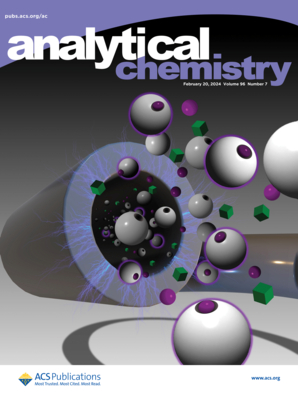载铁蛋白纳米颗粒为基础的质量标签:一种新的金属标记策略,用于质量细胞术。
IF 6.7
1区 化学
Q1 CHEMISTRY, ANALYTICAL
引用次数: 0
摘要
流式细胞术(MC)被认为是下一代流式细胞术(FC),它使用带有金属同位素标记的抗体代替荧光分子进行高维单细胞生物标志物测定,可以同时测量单个细胞的50多个参数。尽管MC具有强大的分析性能,但在现有质量标签的灵敏度和同位素通道方面也存在局限性。本文提出了一种基于载铁蛋白纳米颗粒(AFNPs)制备MC质量标签的新型金属标记策略。在制备AFNPs时,通过被动扩散的方法将稀土金属和磷酸盐离子依次引入到载铁蛋白的空腔中,在载铁蛋白纳米笼内形成金属-磷酸盐核。采用n -羟基琥珀酰亚胺聚乙二醇(MW = 1000, n = 22)马来酰亚胺(NHS-PEG22-MAL)连接剂将AFNPs与抗体连接,制备Ab-NP偶联物。AFNPs与细胞的非特异性结合较低,因此MC检测的背景信号较低。在优化条件下,每个载铁蛋白平均可装载300-800个稀土金属原子,AFNP标签的灵敏度是金属螯合聚合物(MCP)标签的两倍以上。使用我们的AFNP标签对人外周血单核细胞(PBMCs)进行细胞亚群分析的多参数分析显示,FC和MC分析结果具有良好的一致性。该研究提出了一种制备MC质量标签的新策略,该标签不依赖螯合剂,具有多种染色能力,低非特异性结合和高灵敏度。AFNP标签的开发有望推动MC技术的发展。本文章由计算机程序翻译,如有差异,请以英文原文为准。
Apoferritin Nanoparticle-Based Mass Tags: A Novel Metal Tagging Strategy for Mass Cytometry.
Mass cytometry (MC), considered the next generation of flow cytometry (FC), uses antibodies tagged with metal isotopes instead of fluorescent molecules for higher-dimensional single cell biomarker assays and can measure more than 50 parameters simultaneously on individual cells. Despite its powerful analytical performance, MC also has limitations in sensitivity and isotope channels using current mass tags. Herein, a new metal tagging strategy was developed to prepare MC mass tags based on apoferritin nanoparticles (AFNPs). For the preparation of AFNPs, rare-earth metals and phosphate ions were sequentially introduced into the cavity of apoferritin by a passive diffusion method to form a metal-phosphate core inside the apoferritin nanocages. The N-hydroxysuccinimide polyethylene glycol (MW = 1000, n = 22) maleimide (NHS-PEG22-MAL) linker was used to link the AFNPs and antibodies to prepare Ab-NP conjugates. The AFNPs have low nonspecific binding to cells, thus resulting in a low background signal for the MC assay. Under optimized conditions, each apoferritin can load an average of 300-800 rare-earth metal atoms, and AFNP tags have more than twice the sensitivity compared with metal-chelating polymer (MCP) tags. Multiparameter assays for the cellular subset analysis of human peripheral blood mononuclear cells (PBMCs) showed good agreement between FC and MC assays by using our AFNP tags. The study presents a new strategy for preparing MC mass tags that are chelator-independent and have multiple staining capabilities, low nonspecific binding, and high sensitivity. The developed AFNP tags are expected to promote the development of MC technology.
求助全文
通过发布文献求助,成功后即可免费获取论文全文。
去求助
来源期刊

Analytical Chemistry
化学-分析化学
CiteScore
12.10
自引率
12.20%
发文量
1949
审稿时长
1.4 months
期刊介绍:
Analytical Chemistry, a peer-reviewed research journal, focuses on disseminating new and original knowledge across all branches of analytical chemistry. Fundamental articles may explore general principles of chemical measurement science and need not directly address existing or potential analytical methodology. They can be entirely theoretical or report experimental results. Contributions may cover various phases of analytical operations, including sampling, bioanalysis, electrochemistry, mass spectrometry, microscale and nanoscale systems, environmental analysis, separations, spectroscopy, chemical reactions and selectivity, instrumentation, imaging, surface analysis, and data processing. Papers discussing known analytical methods should present a significant, original application of the method, a notable improvement, or results on an important analyte.
 求助内容:
求助内容: 应助结果提醒方式:
应助结果提醒方式:


